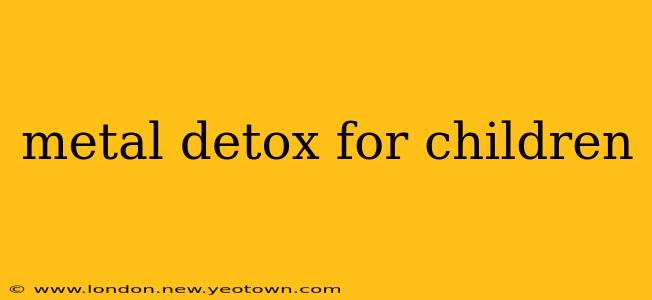The innocent smiles of our children often mask the unseen dangers lurking in our environment. One such danger is exposure to heavy metals, which can subtly impact their development and well-being. While a completely metal-free existence is unrealistic, understanding the risks and implementing proactive strategies can significantly reduce exposure and promote healthy growth. This guide will navigate the complexities of metal detox for children, focusing on prevention, identification, and appropriate actions.
It's crucial to remember that I am an AI and cannot provide medical advice. Always consult your pediatrician or a qualified healthcare professional before making any decisions regarding your child's health. This information is for educational purposes only.
What are Heavy Metals and Why are They Dangerous for Children?
Heavy metals, such as lead, mercury, arsenic, and cadmium, are naturally occurring elements that can contaminate our environment through industrial processes, pollution, and even certain consumer products. Imagine a tiny, invisible villain slowly accumulating in your child's body. These metals are particularly dangerous for children because their developing bodies are more susceptible to their toxic effects. Their smaller size means even small amounts of exposure can have a significant impact, potentially leading to:
- Developmental delays: Heavy metals can interfere with brain development, leading to learning difficulties, speech problems, and behavioral issues.
- Immune system dysfunction: Compromised immune systems make children more vulnerable to infections.
- Neurological problems: From subtle cognitive impairments to more severe conditions, the neurological impact can be devastating.
- Kidney and liver damage: These vital organs can be affected by the accumulation of heavy metals.
What are the Common Sources of Heavy Metal Exposure in Children?
Understanding the sources of exposure is the first step towards effective prevention. Here are some common culprits:
- Lead-based paint: Older homes may contain lead-based paint, which can chip and become ingested by children.
- Contaminated water: Lead and other metals can leach into drinking water from old pipes or industrial contamination.
- Certain foods: Some foods, particularly seafood, can contain high levels of mercury.
- Toys and household items: Some inexpensive toys and household items may contain lead or other heavy metals.
- Air pollution: Industrial emissions and vehicle exhaust can contribute to airborne heavy metal exposure.
How Do I Know if My Child Has Heavy Metal Toxicity?
Early detection is key. However, the symptoms of heavy metal toxicity can be subtle and mimic other childhood illnesses. Common signs might include:
- Fatigue and lethargy
- Developmental delays
- Behavioral problems
- Headaches
- Abdominal pain
- Loss of appetite
Note: These symptoms are not unique to heavy metal toxicity and can be caused by many other factors. A thorough medical evaluation is necessary for accurate diagnosis.
How is Heavy Metal Toxicity Diagnosed in Children?
A healthcare professional will conduct a comprehensive assessment, including a detailed medical history and physical examination. Blood and urine tests can measure the levels of heavy metals in the body. In some cases, hair analysis may also be used.
What are the Treatment Options for Heavy Metal Toxicity in Children?
Treatment depends on the specific metal involved, the severity of the toxicity, and the child's overall health. Chelation therapy, a medical procedure involving the use of chelating agents to bind to and remove heavy metals from the body, may be recommended in severe cases. However, it's crucial to remember that chelation therapy is not without risks, and it should only be undertaken under the strict supervision of a qualified medical professional.
Can I Detox My Child Naturally?
While natural approaches can support overall health, they should not replace medical intervention when heavy metal toxicity is suspected. Focus on a healthy diet rich in fruits, vegetables, and antioxidants, which can support the body's natural detoxification processes. Ensure your child drinks plenty of clean, filtered water. Furthermore, limit their exposure to potential sources of heavy metal contamination, as mentioned above.
What are the Long-Term Effects of Heavy Metal Exposure in Children?
The long-term consequences of heavy metal exposure can be significant, impacting cognitive function, physical health, and overall well-being into adulthood. Early intervention and proactive prevention strategies are essential for minimizing these potential risks.
How can I prevent my child from being exposed to heavy metals?
Prevention is always better than cure! Following these steps can significantly reduce your child’s exposure to heavy metals:
- Test your home for lead-based paint: If you live in an older home, get it tested.
- Use a water filter: A high-quality water filter can remove heavy metals from your drinking water.
- Choose organic foods whenever possible: Organic produce generally has lower levels of pesticide residues and heavy metals.
- Wash hands frequently: Thorough handwashing helps prevent the ingestion of heavy metals.
- Monitor your child's play area: Keep your child's play area clean and free of potential hazards.
Remember, protecting your child's health is a continuous process. By staying informed, implementing preventative measures, and seeking professional guidance when necessary, you can significantly reduce their risk of heavy metal exposure and promote their healthy development.

